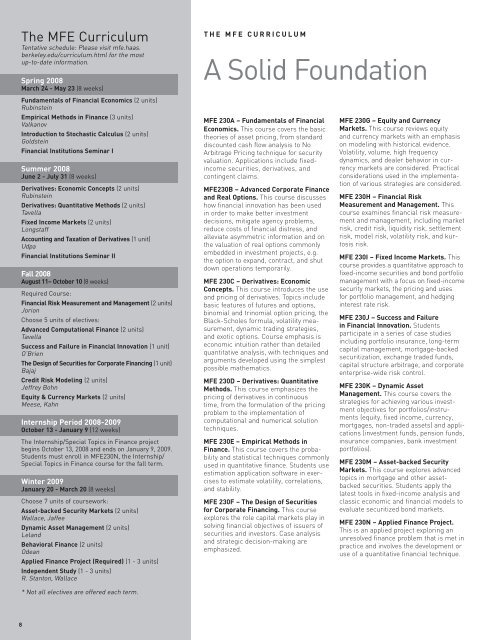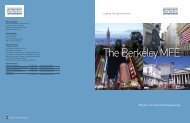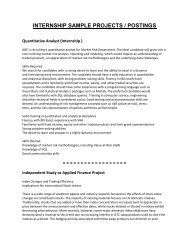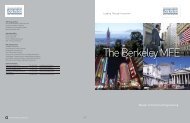The Berkeley MFE.pdf - Master of Financial Engineering Program
The Berkeley MFE.pdf - Master of Financial Engineering Program
The Berkeley MFE.pdf - Master of Financial Engineering Program
You also want an ePaper? Increase the reach of your titles
YUMPU automatically turns print PDFs into web optimized ePapers that Google loves.
<strong>The</strong> <strong>MFE</strong> Curriculum<br />
Tentative schedule: Please visit mfe.haas.<br />
berkeley.edu/curriculum.html for the most<br />
up-to-date information.<br />
Spring 2008<br />
March 24 - May 23 (8 weeks)<br />
THE <strong>MFE</strong> CURRICULUM<br />
A Solid Foundation<br />
Fundamentals <strong>of</strong> <strong>Financial</strong> Economics (2 units)<br />
Rubinstein<br />
Empirical Methods in Finance (3 units)<br />
Valkanov<br />
Introduction to Stochastic Calculus (2 units)<br />
Goldstein<br />
<strong>Financial</strong> Institutions Seminar I<br />
Summer 2008<br />
June 2 - July 31 (8 weeks)<br />
Derivatives: Economic Concepts (2 units)<br />
Rubinstein<br />
Derivatives: Quantitative Methods (2 units)<br />
Tavella<br />
Fixed Income Markets (2 units)<br />
Longstaff<br />
Accounting and Taxation <strong>of</strong> Derivatives (1 unit)<br />
Udpa<br />
<strong>Financial</strong> Institutions Seminar II<br />
Fall 2008<br />
August 11– October 10 (8 weeks)<br />
Required Course:<br />
<strong>Financial</strong> Risk Measurement and Management (2 units)<br />
Jorion<br />
Choose 5 units <strong>of</strong> electives:<br />
Advanced Computational Finance (2 units)<br />
Tavella<br />
Success and Failure in <strong>Financial</strong> Innovation (1 unit)<br />
O’Brien<br />
<strong>The</strong> Design <strong>of</strong> Securities for Corporate Financing (1 unit)<br />
Bajaj<br />
Credit Risk Modeling (2 units)<br />
Jeffrey Bohn<br />
Equity & Currency Markets (2 units)<br />
Meese, Kahn<br />
Internship Period 2008-2009<br />
October 13 - January 9 (12 weeks)<br />
<strong>The</strong> Internship/Special Topics in Finance project<br />
begins October 13, 2008 and ends on January 9, 2009.<br />
Students must enroll in <strong>MFE</strong>230N, the Internship/<br />
Special Topics in Finance course for the fall term.<br />
Winter 2009<br />
January 20 - March 20 (8 weeks)<br />
Choose 7 units <strong>of</strong> coursework:<br />
Asset-backed Security Markets (2 units)<br />
Wallace, Jaffee<br />
Dynamic Asset Management (2 units)<br />
Leland<br />
Behavioral Finance (2 units)<br />
Odean<br />
Applied Finance Project (Required) (1 - 3 units)<br />
Independent Study (1 - 3 units)<br />
R. Stanton, Wallace<br />
* Not all electives are <strong>of</strong>fered each term.<br />
<strong>MFE</strong> 230A – Fundamentals <strong>of</strong> <strong>Financial</strong><br />
Economics. This course covers the basic<br />
theories <strong>of</strong> asset pricing, from standard<br />
discounted cash flow analysis to No<br />
Arbitrage Pricing technique for security<br />
valuation. Applications include fixedincome<br />
securities, derivatives, and<br />
contingent claims.<br />
<strong>MFE</strong>230B – Advanced Corporate Finance<br />
and Real Options. This course discusses<br />
how financial innovation has been used<br />
in order to make better investment<br />
decisions, mitigate agency problems,<br />
reduce costs <strong>of</strong> financial distress, and<br />
alleviate asymmetric information and on<br />
the valuation <strong>of</strong> real options commonly<br />
embedded in investment projects, e.g.<br />
the option to expand, contract, and shut<br />
down operations temporarily.<br />
<strong>MFE</strong> 230C – Derivatives: Economic<br />
Concepts. This course introduces the use<br />
and pricing <strong>of</strong> derivatives. Topics include<br />
basic features <strong>of</strong> futures and options,<br />
binomial and trinomial option pricing, the<br />
Black-Scholes formula, volatility measurement,<br />
dynamic trading strategies,<br />
and exotic options. Course emphasis is<br />
economic intuition rather than detailed<br />
quantitative analysis, with techniques and<br />
arguments developed using the simplest<br />
possible mathematics.<br />
<strong>MFE</strong> 230D – Derivatives: Quantitative<br />
Methods. This course emphasizes the<br />
pricing <strong>of</strong> derivatives in continuous<br />
time, from the formulation <strong>of</strong> the pricing<br />
problem to the implementation <strong>of</strong><br />
computational and numerical solution<br />
techniques.<br />
<strong>MFE</strong> 230E – Empirical Methods in<br />
Finance. This course covers the probability<br />
and statistical techniques commonly<br />
used in quantitative finance. Students use<br />
estimation application s<strong>of</strong>tware in exercises<br />
to estimate volatility, correlations,<br />
and stability.<br />
<strong>MFE</strong> 230F – <strong>The</strong> Design <strong>of</strong> Securities<br />
for Corporate Financing. This course<br />
explores the role capital markets play in<br />
solving financial objectives <strong>of</strong> issuers <strong>of</strong><br />
securities and investors. Case analysis<br />
and strategic decision-making are<br />
emphasized.<br />
<strong>MFE</strong> 230G – Equity and Currency<br />
Markets. This course reviews equity<br />
and currency markets with an emphasis<br />
on modeling with historical evidence.<br />
Volatility, volume, high frequency<br />
dynamics, and dealer behavior in currency<br />
markets are considered. Practical<br />
considerations used in the implementation<br />
<strong>of</strong> various strategies are considered.<br />
<strong>MFE</strong> 230H – <strong>Financial</strong> Risk<br />
Measurement and Management. This<br />
course examines financial risk measurement<br />
and management, including market<br />
risk, credit risk, liquidity risk, settlement<br />
risk, model risk, volatility risk, and kurtosis<br />
risk.<br />
<strong>MFE</strong> 230I – Fixed Income Markets. This<br />
course provides a quantitative approach to<br />
fixed-income securities and bond portfolio<br />
management with a focus on fixed-income<br />
security markets, the pricing and uses<br />
for portfolio management, and hedging<br />
interest rate risk.<br />
<strong>MFE</strong> 230J – Success and Failure<br />
in <strong>Financial</strong> Innovation. Students<br />
participate in a series <strong>of</strong> case studies<br />
including portfolio insurance, long-term<br />
capital management, mortgage-backed<br />
securitization, exchange traded funds,<br />
capital structure arbitrage, and corporate<br />
enterprise-wide risk control.<br />
<strong>MFE</strong> 230K – Dynamic Asset<br />
Management. This course covers the<br />
strategies for achieving various investment<br />
objectives for portfolios/instruments<br />
(equity, fixed income, currency,<br />
mortgages, non-traded assets) and applications<br />
(investment funds, pension funds,<br />
insurance companies, bank investment<br />
portfolios).<br />
<strong>MFE</strong> 230M – Asset-backed Security<br />
Markets. This course explores advanced<br />
topics in mortgage and other assetbacked<br />
securities. Students apply the<br />
latest tools in fixed-income analysis and<br />
classic economic and financial models to<br />
evaluate securitized bond markets.<br />
<strong>MFE</strong> 230N – Applied Finance Project.<br />
This is an applied project exploring an<br />
unresolved finance problem that is met in<br />
practice and involves the development or<br />
use <strong>of</strong> a quantitative financial technique.<br />
8











